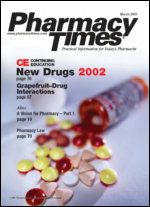Publication
Article
Pharmacy Times
Drug Diversion Versus Pain Management?Part 1
Author(s):
During the past several years, I have had the pleasure of traveling across this great country of ours and speaking to health professionals and law enforcement personnel on the issues surrounding drug diversion. Nothing has caused more controversy between these 2 groups, however, than pain management.
I have had the pleasure of speaking alongside some of the most notable experts on pain management in the United States. I have learned an enormous amount about pain management, and I certainly agree that pain is undertreated in this country. There are several reasons why pain is not adequately treated here, and the first may very well be attributed to prescription drug abusers.
Prescription drug seekers ultimately deprive legitimate patients of needed medication. The problem is even worse than it may seem because the vast majority of folks who consume controlled substances are legitimate patients. Drug seekers steal an inordinate amount of time from the practitioner and the pharmacist that should be given to legitimate patients.
Prescription drug seekers also are willing participants in illegal activities that are made available to them by unscrupulous practitioners and pharmacists. Although the percentage of criminal physicians and pharmacists is very low, each usually contributes to the addiction and trafficking of hundreds of drug diverters. These health professional criminals are eventually arrested and receive considerable notoriety in the news.
This then leads to the next phase of the reason for the undertreatment of pain: health professional paranoia. Legitimate practitioners and pharmacists become afraid that they may be targeted by law enforcement for criminal prosecution. Practitioners greatly reduce their opiate prescriptions or boycott certain pharmaceuticals that they feel are getting attention by the authorities. Whether the paranoia is real or not, the consequences are the same.
During a presentation in the Midwest, I could hardly believe it when an oncologist in the crowd told me that he refuses to write class 2 prescriptions in his practice because of his fear of law enforcement! He admitted that he thought that many of his patients needed the potent analgesics, but he was not willing to take a chance with his license. Instead, he was prescribing hydrocodone, the most abused pharmaceutical substance in the United States.
Some pharmacists refuse to stock certain drugs in their pharmacy for fear that they will fall victim to an armed robber. This may be the foremost reason for some pharmacists, but a strong underlying reason for many is to avoid drug seekers because of their own concern about potential prosecution for dispensing certain drugs.
Law enforcement personnel and regulators can further complicate this issue by perpetuating these fears. They may make inflammatory remarks in the media that show a definite lack of knowledge of pain management, or they may make veiled threats to practitioners and pharmacists whom they perceive to be involved in criminal activity. These tactics only increase the paranoia and decrease the number of legitimate pain patients who will receive medication.
After talking to health professionals about this issue, I am convinced that drug seeking itself is a major obstacle to legitimate pain management. Another significant obstruction is the lack of education for both health professionals and law enforcement personnel on this topic. Next month I will examine the problem of the lack of education, and I will provide some possible solutions in my final article in the series.
John Burke, director of the Warren County, Ohio, drug task force and retired commander of the Cincinnati Police Pharmaceutical Diversion Squad, is a 32-year veteran of law enforcement.
For information, he can be reached by e-mail at [email protected], by phone at 513-336-0070, or via the Web site www.rxdiversion.com.

Newsletter
Stay informed on drug updates, treatment guidelines, and pharmacy practice trends—subscribe to Pharmacy Times for weekly clinical insights.






